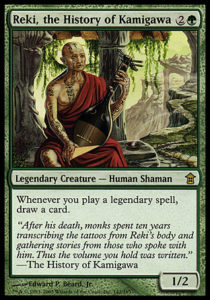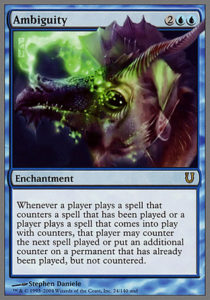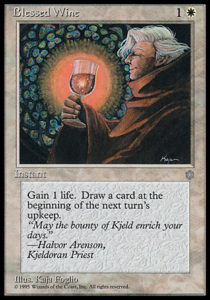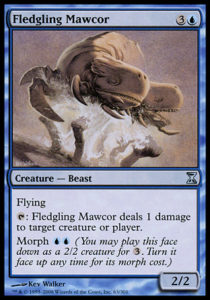Welcome to October, 2006. The school year is begun, the Nintendo Wii releases in a month, and Paul McCartney is 64 years old (having written “When I’m Sixty-Four” when he was sixteen). Ravnica block draft, considered by many to be the best Limited format ever, is old news. Magic has not yet recouped the players lost to Mirrodin’s power creep and Champions of Kamigawa’s power sink, unusual flavor, and Legendary gimmick. Time Spiral has just come out.
Time Spiral was a love song to players who’ve been around since the beginning.
Players who love the flavor and history of the game.
Players who’d be delighted to crack an old-border Avatar of Woe and play with it again.
Players who’d see Barbed Shocker and remember Shocker, an obscure rare from Tempest.
Players who knew who Braids, Cabal Minion was and why Braids, Conjurer Adept was from an alternate reality.
Players who’d recognize Cautery Sliver as a mini-Goblin Legionnaire Sliver (except for the easy-to-miss Sliver-only-clause in its damage prevention) and that Castle Raptors are birds that live in a Castle.
In other words, players like me. When I saw the spoiler, I was delighted by how many cards they’d referenced. The set was meant for people who were around forever and “got it.” The problem was, me and almost all of my friends weren’t playing Magic. I didn’t see the spoiler until four years later. In 2006, much of Magic’s player base hadn’t been around for Ice Age, Tempest, or Odyssey. They wouldn’t know the references. To them, the set was full of random designs, card names, and art choices. Wizards was trying to please lapsed players and was instead confusing many active players. The flavor was amazing, but it was obscure and all over the place.
Time Spiral was the zenith of complexity creep. It had more mechanics than any set ever. It reused the majority of keywords from Magic’s history (sorry, Phasing, Banding, and Islandhome) and if you weren’t around for them the first time, they were effectively new keywords. It introduced a ton of brand-new keywords in Future Sight that were only used on one or two cards each. The sheer volume of information was staggering, to say nothing of battlefield complexity or basic maintenance of the game state.
In a given upkeep, you might have to remember to remove a time counter from Durkwood Baloth and Ravaging Riftwurm (though each had different abilities that did different things when the last counter was removed), add a spore counter to every Thallid, add another spore counter for Sporesower Thallid, think about using Llanowar Augur, and pay echo for Uktabi Drake. You had to differentiate Ravaging Riftwurm’s time counters from the +1/+1 counters it had received from Hunting Moa and Sporesower Thallid’s spore counters from the -1/-1 counters it got when it was shot by Serrated Arrows. After remembering to do all of that, you had to draw for the turn and play Magic.
Time Spiral was paralyzing in its complexity. New players were often lost and even experienced players had difficulty keeping track of everything. The set was not well-received by the general public (though it is beloved by a minority of players). It reminded Wizards that too much of a good thing is not a good thing (a lesson revisited in Shadowmoor) and to ratchet down complexity at common (which would lead to the New World Order).
That said, I love drafting Time Spiral block. Once you know the cards and mechanics and are prepared to play a lot of Magic in your own upkeep, you may savor a delightful vintage draft.
I haven’t had enough TPF drafts under my belt to fully appreciate the various archetypes, but I know several of them. Thallids are draftable (as in Modern Masters), but they’re also in black (Deathspore Thallid can do some work). Black/red madness is an archetype thanks to discard outlets like Gathan Raiders and Urborg Syphon-Mage. Suspend creatures tend to be very good; Knight of Sursi, Keldon Halberdier, and MM powerhouse Errant Ephemeron are powerful creatures that can come down around the turn you’d be able to cast them, with haste, with only a minor mana investment up front.
Last week, I joined Zac, Li, Joel, Connor, Brook, and Kadar at Chase’s place to draft TPF courtesy of Brook. The draft was… interesting. Here’s everyone’s archetypes (if I remember correctly):
Zach—UB madness
Chase—UB
Kadar—UB
Li—Naya Slivers
Zac—Mono-white aggro
Connor—GW aggro
Joel—RG aggro
Brook—BR rare-draft
That’s right; three players were in the same color combination and no one else was in blue (and Brook, the only other player in black, was heavily red). The table was polarized between UB decks and Naya-colored aggro decks.
I faced an interesting choice P1P1: Word of Seizing, Looter il-Kor, and foil Fledgling Mawcor. I opted for the Mawcor (because pingers are very strong in Limited), although the Looter is a very good card, particularly in UB madness where it both finds me the cards I want and is a discard outlet for my madness spells. Word of Seizing is Ray of Command (an insanely powerful card), but color-committing and expensive. The Mawcor single-handedly won me round two against Li’s X/1 slivers, so I feel I didn’t go too far astray.
Time Spiral block draft
You might have noticed that I have a total of 46 spells (I should only have 45; three packs with 15 cards per booster with no basic lands in packs). We had an out-of-order Future Sight pack and things got wonky. It’s something to be avoided, but it happens, particularly when people are drinking and drafting.
My most contentious deckbuilding decision was opting not to splash for Ghostfire or run Prismatic Lens. Ghostfire would hurt my manabase more than I’d like. I didn’t feel that I needed the Prismatic Lens’ ramping more than I did Mystical Teachings (and a full toolbox of instants to search up) and that if I did run the Lens, I’d have to cut Teachings or Pongify. The deck boasted the powerful combination of Serendib Sorcerer and Merfolk Thaumaturgist, absolute bomb Mirri the Cursed, and a madness/delve/Mystical Teachings package to build card advantage over time.
My most exciting match was probably round one against Kadar’s UB build (which also featured a Mystic Teachings package). Our games were grindy, very long, and exciting. We traded off resources for a while, I flooded out, then burnt through every land in my deck thanks to Dreamscape Artist. There are few feelings so grand as knowing that whatever’s on top of your library, you’re drawing live (I might have even named something after this feeling).
At the end of the night, I went 3-0, beating Kadar in the mirror, Li’s Sliver deck (thanks entirely to my Mawcor), and Connor’s GW beats (which stumbled, making for an anticlimactic final game—normally my matches with Connor are exciting and close, plus Connor’s a great guy I rarely get the privilege of playing with).
That’s all for me this week. I’d love to hear from you. What are your memories of Time Spiral block? Which formats would you like to see covered in future Flashback Drafts?
As ever, thanks for reading.
—Zachary Barash
twitch.tv/ZennithGP—join the livestream!
Zachary Barash has been playing Magic on and off since 1994. He loves Limited and drafts every available format (including several that aren’t entirely meant to be drafted). He’s a proud Cube owner and performer, improvising entire musicals every week with his team, Petting Zoo. Zach has an obsession with Indian food bordering on the unhealthy.





